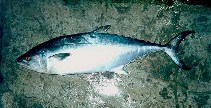Orcynopsis unicolor (GeoffroySaint-Hilaire, 1817)
Plain bonito
Adicionar sua observação em Fish Watcher
| Native range | All suitable habitat | Point map | Year 2050 |

|
| This map was computer-generated and has not yet been reviewed. |
| Orcynopsis unicolor AquaMaps Data sources: GBIF OBIS |
Carregue seu(sua) Fotos e vídeos
Pictures | Imagem do GoogleOrcynopsis unicolor
Picture by Meyer, T.
Pictures | Imagem do GoogleOrcynopsis unicolor
Picture by Meyer, T.
Common names from other countries
Classificação / Names Nomes comuns | Sinônimos | Catalog of Fishes(Gênero, Espécies) | ITIS | CoL | WoRMS | Cloffa
> Scombriformes (Mackerels) > Scombridae (Mackerels, tunas, bonitos) > Scombrinae
Etymology: Orcynopsis: Greek, orkynos, -ou = a kind of tunna + Greek, opsis = similar to (Ref. 45335).
Etymology: Orcynopsis: Greek, orkynos, -ou = a kind of tunna + Greek, opsis = similar to (Ref. 45335).
Environment: milieu / climate zone / depth range / distribution range Ecologia
marinhas; estuarina; oceanódromo (Ref. 51243); intervalo de profundidade 4 - ? m (Ref. 122150). Subtropical; 60°N - 13°S, 18°W - 36°E
Distribuição Países | Áreas da FAO | Ecossistemas | Ocorrências | Point map | Introduções | Faunafri
Eastern Atlantic: Oslo, Norway south to Dakar, Senegal but the range is centered in the southern Mediterranean Sea. Not known from Madeira, the Canary Islands or Cape Verde.
Comprimento de primeira maturação / Tamanho / Peso / Idade
Maturity: Lm 75.0, range 70 - 80 cm
Max length : 130 cm FL macho/indeterminado; (Ref. 168); common length : 90.0 cm FL macho/indeterminado; (Ref. 168); peso máx. publicado: 13.1 kg (Ref. 168)
Max length : 130 cm FL macho/indeterminado; (Ref. 168); common length : 90.0 cm FL macho/indeterminado; (Ref. 168); peso máx. publicado: 13.1 kg (Ref. 168)
Descrição suscinta Chaves de identificação | Morfologia | Morfometria
Espinhos dorsais (total) : 12 - 14; Raios dorsais (total) : 12 - 15; Raios anais : 14 - 16. Mouth rather large, upper jaw reaching to hind margin of eye. Laminae of olfactory rosette 25 to 28. Interpelvic process small and bifid. Body naked behind the well developed corselet. Swim bladder absent. Vertebrae 17 or 18 precaudal plus 19 to 21 caudal, total 37 to 39. Anterior three quarters of first dorsal fin black.
Adults are neritic, confined primarily to temperate waters, but juveniles may be encountered in waters of up to 30°C. Form small schools at the surface so that the first dorsal fin stands out of the water like that of sharks, also frequently associated with birds. Feed on small fishes, especially sardines, anchovies, jacks, mackerel, bogue and others. Eggs and larvae are pelagic (Ref. 6769). Marketed canned or frozen.
Ciclo de vida ou comportamento de acasalamento Maturidade | Reprodução | Desova | Ovos | Fecundidade | Larvas
A female weighing 5 or 6 kg may carry some 500 to 600,000 eggs which are spawned in portions.
Referência principal
Upload your references | Referências | Coordenador : Collette, Bruce B. | Colaboradores
Collette, B.B. and C.E. Nauen, 1983. FAO Species Catalogue. Vol. 2. Scombrids of the world. An annotated and illustrated catalogue of tunas, mackerels, bonitos and related species known to date. Rome: FAO. FAO Fish. Synop. 125(2):137 p. (Ref. 168)
Status na Lista Vermelha da UICN (Ref. 130435: Version 2024-2)
Segura ou pouco preocupante (LC) ; Date assessed: 01 March 2022
Ameaça para os humanos
Harmless
Uso pelos humanos
Pescarias: pouco comercial; peixe esportivo: sim
FAO(pescarias: produção; publication : search) | FishSource | Sea Around Us
Mais informação
Population dynamics
Parâmetros de crescimento
Max. ages / sizes
Length-weight rel.
Length-length rel.
Frequências de comprimento
Conversão de massa
Recrutamento
Abundância
Parâmetros de crescimento
Max. ages / sizes
Length-weight rel.
Length-length rel.
Frequências de comprimento
Conversão de massa
Recrutamento
Abundância
Life cycle
Reprodução
Maturidade
Fecundidade
Desova
Spawning aggregations
Ovos
Desenvolvimento dos ovos
Larvas
Dinâmica larval
Reprodução
Maturidade
Fecundidade
Desova
Spawning aggregations
Ovos
Desenvolvimento dos ovos
Larvas
Dinâmica larval
Anatomy
Área branquial
Brain
Otolith
Área branquial
Brain
Otolith
Physiology
Body composition
Nutrients
Consumo de oxigênio
Tipo de natação
Velocidade de natação
Visual pigments
Fish sound
Diseases & Parasites
Toxicity (LC50s)
Body composition
Nutrients
Consumo de oxigênio
Tipo de natação
Velocidade de natação
Visual pigments
Fish sound
Diseases & Parasites
Toxicity (LC50s)
Genetics
Genética
Heterozygosity
Hereditariedade
Genética
Heterozygosity
Hereditariedade
Human related
Aquaculture systems
Perfis para aquacultura
Estirpes
Ciguatera cases
Stamps, coins, misc.
Aquaculture systems
Perfis para aquacultura
Estirpes
Ciguatera cases
Stamps, coins, misc.
Ferramentas
Livro eletrônico | Guia de campo | Chaves de identificação | Ferramenta auxiliar de frequências de comprimento | Ferramenta sobre a história de vida | Mapa de pontos | Classification Tree
| Catch-MSY |
Relatórios especiais
Checar Manutenção em Aquário | Checar Planilhas de Fatos sobre as Espécies | Checar Planilhas de Fatos sobre Aquicultura
Baixar XML
Fontes da internet
Aquatic Commons | BHL | Cloffa | Websites from users | Checar Observador de Peixes (FishWatcher) | CISTI | Catalog of Fishes(Gênero, Espécies) | DiscoverLife | ECOTOX | Faunafri | Fishtrace | GenBank(genoma, nucleotídeo) | GloBI | GOBASE | | Google Books | Google Scholar | Google | IGFA World Record | MitoFish | Bases de dados nacionais | Otolith Atlas of Taiwan Fishes | PubMed | Reef Life Survey | Scirus | SeaLifeBase | Árvore da vida | Wikipedia(Ir para, procura) | World Records Freshwater Fishing | Registro zoológico
Estimates based on models
Preferred temperature (Ref. 115969): 12.5 - 23.5, mean 16.3 (based on 264 cells).
Índice de diversidade filogenética (Ref. 82804): PD50 = 1.0000 [Uniqueness, from 0.5 = low to 2.0 = high].
Bayesian length-weight: a=0.00955 (0.00460 - 0.01984), b=3.06 (2.89 - 3.23), in cm Total Length, based on LWR estimates for this (Sub)family-body shape (Ref. 93245).
Nível Trófico (Ref. 69278): 4.5 ±0.80 se; based on food items.
Resiliência (Ref. 120179): médio(a), tempo mínimo de duplicação da população 1,4 - 4,4 anos (Assuming tm<=4).
Fishing Vulnerability (Ref. 59153): Very high vulnerability (87 of 100).
Climate Vulnerability (Ref. 125649): Moderate to high vulnerability (52 of 100).




